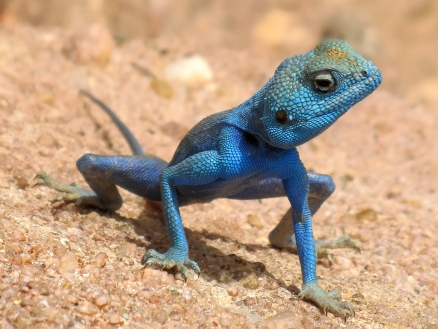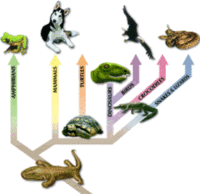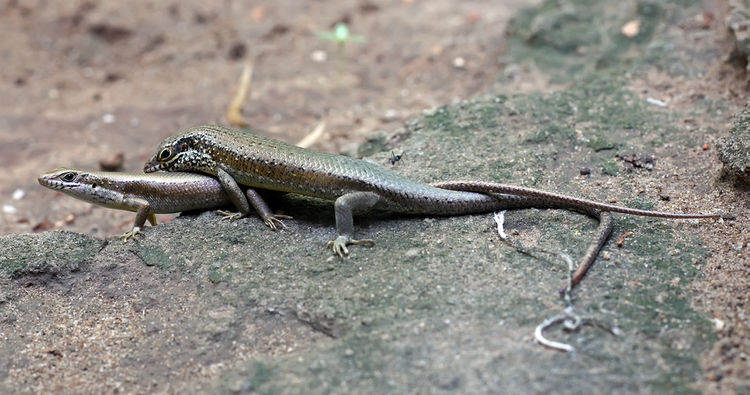Reptile
| Topics: |

Male Agama sinaita, Jordan. This species is common in deserts around the shores of the Red Sea. While in heat, the male turns striking blue to attract females. (Ester Inbar, available from http://commons.wikimedia.org/wiki/User:ST. [Attribution], via Wikimedia Commons)
Contents
Definition
Reptiles do not form a distinct evolutionary group as birds and mammals do. Rather, the Class Reptilia consists of four orders which are very different from each other. For example, lizards are more closely related to birds than to turtles!
As a result, reptiles are as easily defined by what they aren't as by what they are.
As opposed to mammals and birds, reptiles have neither fur nor feathers, but scales. Reptiles can not be confused with amphibians because reptiles have dry, water-proof skin and eggs, as well as internal fertilization and more advanced circulatory, respiratory, excretory, and nervous systems.
Evolution
 (Source: Biodiversity Institute of Ontario)
(Source: Biodiversity Institute of Ontario) Reptiles evolved from labyrinthodont amphibians 300 million years ago. The success of this terrestrial vertebrate group is due in large part to the evolution of shelled, large-yolked eggs in which the embryo has an independent water supply. This advance, as well as the development of internal fertilization, enabled reptiles to be the first vertebrates to sever their ties with water. They radiated out across the landscape, diversifying quickly and becoming the dominant life form on the planet during the Mesozoic Era, otherwise known as the age of the reptiles.
This cladogram is a very approximate illustration of the complex evolutionary relationships among vertebrates. It shows several things:
- all vertebrates evolved from an amphibian ancestor thought to have been a labyrinthodont.
- amphibians diverged from the other vertebrates very early on.
- turtles, crocodiles, and dinosaurs appeared before the other vertebrate taxa.
- dinosaurs, birds, crocodiles, and snakes are more closely related to each other than to turtles or mammals.
Reproduction
While the process of copulation and egg-laying differs slightly among reptiles, they share the ability to produce a large-yolked, shelled egg. This evolutionary innovation allowed them to dominate the terrestrial landscape for 100 million years. Some lizards and snakes have advanced a step further, evolving the ability to retain their eggs internally until they have hatched, and giving birth to fully developed young (this is called vivipary).
Most reptiles, however, lay eggs which have leathery shells which are resistant to drying. Inside, the amnion encloses the embryo in a protected, moist environment in which nourishment is supplied by the yolk sac, and metabolic waste is stored by the allantois. Parental care is very rare in reptiles. In most species, the young are independent from the moment they've hatched.
Poikilothermic
Reptiles are poikilothermic, which means that they can not regulate heat internally (as opposed to birds and mammals which are homeothermic). However, the name "cold blooded" is a misnomer, because reptiles can maintain high body temperatures by relying on external sources of heat. Reptiles bask in the sun to increase their body temperature or hide in their burrows or in water to cool down. At northern latitudes, during cold periods, reptiles are dormant from a few days to several months, their body processes slowed until temperatures increase.
Conservation  Snake skin that has been shed on a palm tree in West Bengal, India (Source: Saikat Basu, own work)
Snake skin that has been shed on a palm tree in West Bengal, India (Source: Saikat Basu, own work)
Seventeen of Canada's reptiles and amphibians have already been listed by the Committee on the Status of Endangered Wildlife in Canada (COSEWIC) as being at risk from extinction and another twenty four species are under review. The committee was initiated in 1977 and continues to use scientific evidence to determine which species are at risk in Canada. COSEWIC uses several categories to encompass the various types of threat to a species, as well as to define the degree of their vulnerability to extinction should circumstances remain unchanged.
Four of COSEWIC'S categories apply to Canadian reptiles and amphibians:
Extirpated: A species that is no longer living in the wild in Canada, but occurs elsewhere. The Pygmy short horned lizard (Phrynosoma douglassii) is extirpated.
Vulnerable: A species of special concern because of characteristics that make it particularly sensitive to human activities or natural events. These Canadian reptiles are listed as vulnerable:
- spotted turtle (Clemmys guttata)
- wood turtle (Clemmys insculpta)
- northern prairie skink (Eumeces septentrionalis)
- eastern yellow-bellied racer (Coluber constrictor flaviventris)
- eastern short-horned lizard (Phrynosoma douglassi brevirostre)
- eastern hognose snake (Heterodon platirhinos)
Threatened: A species likely to become endangered if limiting factors are not reversed. Three reptile species are considered threatened in Canada:
Endangered: A species facing imminent extirpation (no longer existing in the wild in Canada, but occurring elsewhere)or extinction. These reptile species are endangered:
- Lake Erie water snake (Nerodia sipedon insularum)
- blue racer snake (Coluber constrictor foxii)
- leatherback turtle (Dermochelys coriacea)
 Green Sea Turtle grazing seagrass at Akumal bay (By P.Lindgren (Own work) (http://creativecommons.org/licenses/by-sa/3.0), via Wikimedia Commons)
Green Sea Turtle grazing seagrass at Akumal bay (By P.Lindgren (Own work) (http://creativecommons.org/licenses/by-sa/3.0), via Wikimedia Commons)
Taxonomy
 The traditional class Reptilia (green field) includes all amniotes which are not mammals or birds, making it a paraphyletic group. (By Petter Bøckman (Own work) Domain, via Wikimedia Commons)
The traditional class Reptilia (green field) includes all amniotes which are not mammals or birds, making it a paraphyletic group. (By Petter Bøckman (Own work) Domain, via Wikimedia Commons)
Living species of the class Reptilia are placed in four orders. The order Testudines includes turtles, the order Squamata includes lizards and snakes, the order Crocodylia contains crocodiles and alligators, and the order Rhynchocephalia contains the lizard-like tuataras. Only the Testudines and Squamata are represented in Canada by 17 aquatic or semi-aquatic species of turtles and 10 aquatic or semi-aquatic snakes. There are no aquatic lizards in Canada. The following is the classification of the aquatic reptiles of Canada.
- KINGDOM: Animalia
- PHYLUM: Chordata
- CLASS: REPTILIA
- ORDER: TESTUDINES - TURTLES
- Family: Chelydridae
- Species: Chelydra serpentina - snapping turtle
- Family: Kinosternidae
- Species: Sternotherus odoratus - common musk turtle
- ** Family: Emydidae
- Species: Clemmys guttata - spotted turtle
- Clemmys insculpta - wood turtle
- Clemmys marmorata - western pond turtle
- Chrysemys picta - painted turtle
- Graptemys geographica - map turtle
- Emydoidea blandingii - Blanding's turtle
- Trachemys scripta - Red-eared slider (introduced)
- Species: Clemmys guttata - spotted turtle
- Family: Dermochelyidae
- Species: Dermochelys coriacea - leatherback turtle
- Family: Cheloniidae
- Species: Caretta caretta - loggerhead turtle
- Lepidochelys kempi - Atlantic ridley turtle
- Chelonia mydas - green turtle
- Family: Trionchidae
- Species Apalone spinifera - spiny softshell
- KINGDOM: Animalia
- PHYLUM: Chordata
- CLASS: REPTILIA
- ORDER: SQUAMATA - LIZARDS and SNAKES
- Family: Boidae
- Species: Charina bottae - rubber boa
- ** Family: Colubridae
- Species: Nerodia sipedon - water snake
- Regina septemvittata - queen snake
- Storeria dekayi - brown snake
- Thamnophis sirtalis - common garter snake
- Thamnophis radix - plains garter snake
- Thamnophis elegans - wandering garter snake
- Thamnophis sauritis - ribbon snake
- Elaphe vulpina - fox snake
- Species: Nerodia sipedon - water snake
- Family: Viperidae
- Species: Sistrurus catenatus - Massasauga rattlesnake


